Jillian Stansbury, ND
Botanical Insights
Herbal Specifics
Renal colic due to kidney stones can present as vague to excruciating pain, no matter the size of calculi. Renal colic pain is not due to the stone itself, but rather is due to obstruction of the urinary flow by the kidney stone causing increased pressure on the urinary tract wall, smooth muscle spasms of the ureter, edema and inflammation near the stone, and increased ureteral peristalsis. When the symptoms are severe, patients may present to the emergency room due to the intolerable nature of the pain. I have seen several patients the day after having been seen in the ER, still in pain but now with a thousand dollar (or higher) bill and an opiate prescription.
Although opiates take the edge off the pain, the pain returns when the drugs wear off, they cause lethargy and constipation, and they do little to actually move or treat the stone.1 Opiates deaden the pain sensation, but are actually not renal antispasmodics and they do nothing to improve urine flow or resolve obstruction. In contrast, herbal medicines can relax spastic ureters, and demulcent agents can help lubricate and soothe inflamed urinary mucosal tissues. This article reviews the best herbal medicines to include in formulas for acute renal colic.
Herbal protocols for renal colic should be implemented as soon as possible, since the longer a renal calculus sits in the ureter, the more edematous and swollen the ureter can become, contributing to the obstructive symptoms and the body’s inability to dislodge the stone. Urinary antispasmodic herbs, along with mucilaginous herbs, may reduce ureteral inflammation and spasm, prevent edematous swelling of the tissues, and assist the natural ability of the ureter to move a stone along toward the bladder.
Urinary Antispasmodics
Among our most powerful renal antispasmodics are Piper methysticum – the ace in the hole – along with Lobelia inflata, Viburnum opulus, Aesculus hippocastanum, Ammi visnaga, Dioscorea villosa, Gelsemium sempervirens, Atropa belladonna, and Hyoscyamus niger. I call Piper methysticum (kava) my “ace in the hole” herb because it is powerful, works quickly, and has an affinity for urinary smooth muscle. A Piper methysticum alkaloid, kawain, is in part responsible for numbing sensations in oral and other mucous membranes, due to its effects on potassium ion flow, and it contributes to urinary anodyne effects.
Many Apiaceae family plants may relax urinary smooth muscles by inhibiting calcium ions channels, including Apium graveolens, Petroselinum crispum, Foeniculum vulgare, and the low-dose-only botanical, Conium maculatum. These herbs are emphasized in folkloric formulas for renal pain, bronchospasm, and hypertension due to their muscle-relaxing effects on urinary, respiratory, and vascular muscle fibers. Conium however, is potentially toxic, so should be used only in small doses by skilled clinicians.
Ammi visnaga (khella) is also in the Apiaceae family and useful for relaxing spasms in the ureters; it’s further discussed in an accompanying side bar. Use khella in teas or tincture, or apply hot compresses to the back to facilitate the passing of a stone. Angelica sinensis (dong quai) is another Apiaceae family plant with numerous circulatory and anti-allergy effects; as a result, it may help individuals with urinary symptoms due to food or chemical sensitivity, as well as those with renal pathologies involving poor circulation, such as diabetic nephropathy. Angelica has been shown to normalize the vasodilating substance nitric oxide, which, when elevated, may trigger detrusor and other urinary smooth muscle overactivity. Angelica may be best for patients with overactive bladder. It has a less powerful anodyne action than kava or khella, but may be included in recovery formulas or broad protocols, or be used for patients with indwelling stents or to support recovery following lithotripsy. Salvia miltiorrhiza and Pueraria mirifica may also be used in convalescent formulas to improve circulation to the kidneys and urinary tissues.2
Atropa belladonna and Hyoscyamus are both Solanaceae family plants containing tropane alkaloids that have antispasmodic effects on the gut and urinary passages; however, the oral dosage must be limited due to toxic and possibly hallucinogenic side effects. Tropane alkaloids in these plants, including atropine and hyoscyamine, are muscarinic antagonists that block the stimulating effects of cholinergic activity, thus relaxing urinary tone. These herbs are further discussed in an accompanying sidebar.
Mucilaginous herbs are best used in teas to reap the benefits of their substantial mucosal soothing effects. In order to glean the most powerful demulcent effect, such mucilaginous herbs should be macerated for many hours, even overnight, to best extract their mucilaginous components. Aim for a tea that is thick and slimy. The tea can always be thinned down with mint or licorice teas if the thick nature of such teas is distasteful to an individual patient. Althea offinalis is a personal favorite for such purposes, and can be macerated using 1-2 tsp per cup of cold water. Let stand for many hours before bringing it to a brief simmer. Remove from the heat after 5-10 minutes, and let stand until cool enough to strain.
Neurologic Control of Urinary Smooth Muscle
Urinary muscle tone is controlled by both cholinergic and adrenergic signaling, along with numerous other mechanisms affecting these pathways.3 Although the detrusor muscle contracts during micturition under the control of parasympathetic cholinergic mechanisms, the adrenergic system plays a significant role in the resting tone of the bladder. For example, stress incontinence may involve deficient urinary tone, in which case increasing adrenergic input may be beneficial, whereas in overactive bladder and urinary pain and spasm, blockage of adrenergic signaling may be beneficial.
Alpha (α)-adrenergic receptor activation leads to urinary smooth muscle contraction, while beta (β)-adrenergic receptors generally promote relaxation of the detrusor and urinary smooth muscles.4 Therefore, blockade of α-adrenergic receptors and promotion of β-adrenergic signaling may reduce ureteral colic pain and improve flow around calculi, thereby reducing obstruction and clearing hydronephrosis. Adrenoceptors are most prominent in the lower urinary tract, especially the prostate, urethra, and bladder neck, increasing in density toward the bladder neck and urethra, and are targeted in cases of urinary retention, prostatic enlargement, and urinary obstruction.5,6
Beta-adrenoceptors occur in the ureter, and, along with α-adrenergic antagonists, may help a ureteral stone to enter the bladder. Beta-3 receptors promote relaxation of urinary muscle especially by interfering with ion flow,7 and may complement antimuscarinic/cholinergic agents in the treatment of renal stones and acute ureteral colic. Beta-3 agonists are being investigated for the treatment of lower urinary tract symptoms, including benign prostate hyperplasia (BPH), prostate cancer, and erectile dysfunction. Beta-3 agonists direct calcium-activated potassium channels, a major regulator of urinary smooth muscle contractility. Calcium is essential for the maintenance of action potential in the ureter duct and also for contraction of the ureter. In addition to adrenergic agents, calcium channel blockers may inhibit the influx of calcium and therefore have a spasmolytic effect on the activity of the ureter. Nifedipine, a calcium channel blocker inspired by Ammi visnaga constituents, is commonly used in the treatment of hypertension and angina, and may reduce ureteral contraction without impairing the resting ureteral tone and peristaltic rhythm.8
Cholinergic innervation to urinary muscle involves activity at both muscarinic and nicotinic receptors in the bladder and ureters.9 In mammals, cholinergic signaling from postganglionic parasympathetic fibers results in the release of ATP and triggers complex cascades affecting ion channel activity; it also contributes to urinary muscle tone. Both muscarinic and adrenergic receptors in urinary tissues receive cholinergic input. Muscarinic type-3 receptors, in particular, mediate urinary smooth muscle contractility by suppressing the downstream activation of β-adrenergic receptors. Lobelia inflata and tropane alkaloids may have a spasmolytic action due to effects on cholinergic transmission.
Therapeutic Agents for Renal & Ureteral Colic
The α1-adrenoceptor antagonist, tamsulosin, is often prescribed allopathically for those with acute renal calculi. Serenoa repens (saw palmetto) is used to reduce the obstructive symptoms of BPH and may also be considered as a supportive, although is not a particularly anodyne ingredient in formulas for renal colic. Serenoa is both an α1-adrenoceptor- and muscarinic cholinoceptor antagonist10; however, research has concentrated on its effect on BPH symptoms, and no research as yet has investigated whether it might reduce hydronephrosis due to ureteral obstruction or otherwise resolve related symptoms of urinary obstruction.
Herbal β-agonists may have spasmolytic effects on the ureters. Pharmaceutical β-adrenoreceptor agonists include albuterol, well-established as a bronchial muscle spasmolytic in the treatment of asthma, especially in nebulized form. Albuterol and other β-adrenoreceptor agonists may also improve the passage of renal calculi when used systemically, and also possibly topically.11 Many stimulants, eg, the sympathomimetic amines, such as caffeine, aminophylline, and ephedrine, are β-adrenoreceptor agonists, but they appear to have a greater effect on bronchial smooth muscle than on ureteral muscles. Nonetheless, small amounts may be complementary in herbal tea formulas.
Tropane alkaloids that are found in Solanaceae family plants include atropine, hyoscyamine, and scopolamine, and all have a spasmolytic effects on urinary smooth muscle due to antimuscarinic (also commonly referred to as anticholinergic) effects.12 Tropane alkaloids are a combination of piperidine and pyrrolidine rings, and piperidine alkaloids may also have antispasmodic effects on urinary muscles. Piperidine alkaloids, which are notably high in Lobelia, also reduce urinary contractility via muscarinic blockade13 and nicotinic agonism. Lobelia inflata is most well known for its use in wheezing and to relax respiratory smooth muscles; however, Lobelia may also relax cardiac muscle, skeletal muscle, uterine muscle, and urinary smooth muscle fibers. Much of the antispasmodic effects of Lobelia are credited to piperidine alkaloids in the leaves and especially fresh seed pods, and include lobeline, lobelanine, and lobelanidine. Lobeline may act as both an agonist and antagonist to beta nicotinic receptors, depending on the receptor subtype and situation.14,15 Tropane alkaloids can only be used in small doses as muscarinic antagonists,16 due to possible side effects such as bradycardia, hypotension, tremors, dry mouth, diarrhea, etc. However, they can be a valuable part of an herbal therapy when used in low and moderate dosages.
Formulas for Acute Renal Colic
Following are examples of how to use these herbs to help allay renal pain due to calculi as rapidly as possible. These formulas should be complemented by drinking ample water and eating a light diet that is high in vegetables and low in protein and animal products. These formulas offer a 3-pronged approach to alleviating renal colic by employing a tea, a tincture, and a topical therapy simultaneously. These formulas, as in all of my articles, are simply examples; other similar herbs with similar physiologic actions may be substituted. The accompanying sidebars offer several materia medica details reviewing the specific indications of these helpful herbs.
Tea Formula for Acute Renal Colic

This is an example of Althea used as a demulcent in a tea. For the most powerful pain-relieving effects, cold-macerate the herb for many hours before simmering. However, when such a tea is required immediately, prepare a batch for immediate use without the long maceration. But start a second batch at the same time, to be ready to use later. This formula combines the demulcent effects of Althea with the antispasmodic and pain-relieving effects of Piper methysticum. Glycyrrhiza glabra (licorice) offers its own demulcent and anti-inflammatory effects, while also improving the flavor of the tea.
- Piper methysticum: 1 oz
- Glycyrrhiza: 1 oz
- Althea: 2 oz
Briefly simmer 3 tbsp of the blend in 10 cups of hot water. Strain and drink as much as possible, slowly by the sip-full, every 5-10 minutes. Plan ahead for the next batch by macerating Althea in cold water.
Tincture for Acute Renal Colic
The tea listed above can be complemented by this tincture. Aggressive doses are best, not only to help allay pain, but to help prevent the ureter from becoming edematous and swollen around the stone. This formula employs the potentially toxic Hyoscyamus herb, used safely here with just 4 mL drops in the formula. When taken every 10 minutes, such a formula may provide significant pain relief but also relax ureteral spasms, thus helping a stone to pass.
- Piper methysticum: 20 mL
- Lobelia: 14 mL
- Ammi visnaga: 12 mL
- Aesculus: 10 mL
- Hyoscyamus: 4 mL (optional, for licensed practitioners only)
Take 20-30 gtt every 10-30 min for acute renal colic, reducing dose and frequency as symptoms abate.
Topical Heat Pack for Renal Colic
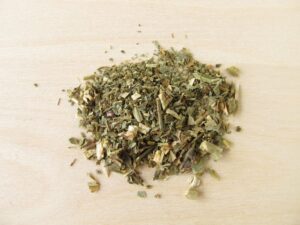
Lobeline in Lobelia, like many alkaloids, is better extracted in an acidic menstruum than in a simple aqueous menstruum. The use of Hyoscyamus tincture may boost its antispasmodic effects; if available as an oil, this form would be suitable as well. Atropa belladonna is used here, as it is more readily available, perhaps even as an oil for topical use.
COMPRESS
- Lobelia “vinegar” tea: 1 cup
- Atropa belladonna tincture: 1 tsp
- Aesculus dried nut slices
OIL
- Castor oil: 1 tbsp
- Mentha essential oil: 30 gtt
- Apium essential oil: 30 gtt
To prepare the Lobelia vinegar “tea,” saturate 2 tbsp of dry Lobelia in apple cider vinegar and let stand for 15 min or more. Add 2 cups of water, ½ cup of Aesculus pieces, and bring to a gentle simmer for 10 min. Remove from heat and let stand 10 min more, then strain. Soak a thick washcloth or dish towel in the hot tea, add a tsp of belladonna tincture to the moist compress, and apply to an oiled back and flank. The castor oil-based oil may help wick the escin, lobeline, and atropine deeper into the body, and the essential oils blended into the castor oil may also offer immediate pain relief. Leave the compress, which may be covered with heat for additional anodyne effects, in place for 20-30 min. Begin preparing subsequent compresses while each compress is in place, so as to be able to replace with a fresh compress every 30-45 min. Omit the belladonna should dry mouth or visual disturbances occur.
Convalescent Tea Formula – To Recover from & Prevent Urinary Calculi
This tea formula may help traumatized tissue recover, and – for those with chronic stones – may help prevent a recurrence. This large recipe will yield 1 lb of tea to be stored in a glass jar and consumed daily during the convalescent period, and at least 3-4 times per week to prevent stones when recurrent.
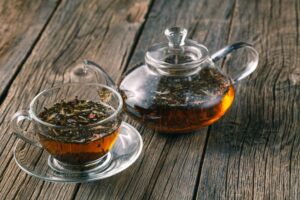
- Salvia mitiorrhiza root: 3 oz
- Pueraria mirifica root: 3 oz
- Angelica sinensis root: 3 oz
- Urtica spp root: 3 oz
- Glycyrrhiza glabra root: 2 oz
- Apium graveolens seeds: 1 oz
- Zingiber officinale root: 1 oz
Gently simmer 1 heaping tbsp in 4 cups of water for 10 min. Remove from the heat and let stand covered for 10 min more. Strain and drink the entire batch over the course of a day. May chill if prefer to consume cold or mix into the day’s drinking water.
Atropa belladonna & Hyoscyamus niger for Urinary Pain
The tropane alkaloid most commonly found in Solanaceae (nightshade) family plants can be used to treat a variety of painful muscle spasms. Atropa belladonna has been historically used to treat acute febrile nephritis, renal engorgement, and nocturnal incontinence, and the Eclectic physicians reported the medicine to stimulate the kidneys, as well as relieve irritability of the kidneys and bladder.
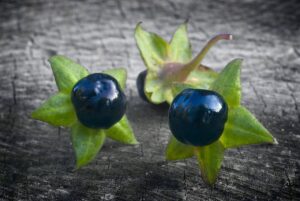 Atropa belladonna is particularly susceptible to biphasic effects, having one effect at a low dose, and differing effects at higher dosages. For example, Atropa may help bedwetting in children due to hyperexcitability of the bladder, yet can also improve urinary flow in cases of urinary retention. Atropa belladonna can be included in formulas for renal colic due to antispasmodic effects on urinary muscle, and can relieve renal congestion and associated renal pain and fullness. Atropa can be used in both tinctures and topical oils to help reduce the pain of acute renal colic, and may be crafted into urethral suppositories for some acute urinary spastic situations. The individual tropane alkaloids, hyoscine and hyoscyamine, have also been employed intranasally and intravenously.17
Atropa belladonna is particularly susceptible to biphasic effects, having one effect at a low dose, and differing effects at higher dosages. For example, Atropa may help bedwetting in children due to hyperexcitability of the bladder, yet can also improve urinary flow in cases of urinary retention. Atropa belladonna can be included in formulas for renal colic due to antispasmodic effects on urinary muscle, and can relieve renal congestion and associated renal pain and fullness. Atropa can be used in both tinctures and topical oils to help reduce the pain of acute renal colic, and may be crafted into urethral suppositories for some acute urinary spastic situations. The individual tropane alkaloids, hyoscine and hyoscyamine, have also been employed intranasally and intravenously.17
Hyoscyamus niger (henbane), the source of these tropane alkaloids and another Solanaceae family plant used in traditional medicine for centuries, is often claimed to be the most powerful urinary antispasmodic of the family. Include Hyoscyamus in formulas for renal colic, as well as for urinary retention and distension of the bladder,18 due to its reliable anti-inflammatory, analgesic, and urinary bladder-relaxant properties.
Hyoscyamus may reduce neural hyperexcitability,19 as well as provide calcium channel-blocking and anticholinergic effects in digestive and urinary smooth muscle. One investigation showed Hyoscyamus to have a greater effect on urinary muscle than digestive muscle, requiring 10 to 25 times the dose to elicit the same antispasmodic action in the gut.19 Whole-plant extracts of Hyoscyamus are likely superior to isolated alkaloids or other compounds.
Hyoscine N-butylbromide is a semi-synthetic medication that combines the tropane alkaloid, hyoscine, with bromide. The medication has been evaluated in human clinical trials for patients with large, distal ureteral stones measuring 5-10 mm, but was found inferior to α-blockers for promoting spontaneous passage of the calculi.20 Other studies suggest that the combination of α-blockers and antimuscarinics may be more effective against ureteral pain than either therapy alone.21 While small doses of Hyoscyamus and Atropa may enhance the expulsion of stones, large dosages may lead to urinary retention or can even cause renal colic. The formulas listed in this article exemplify appropriate dosing strategies.
Piper methysticum for Urinary Pain
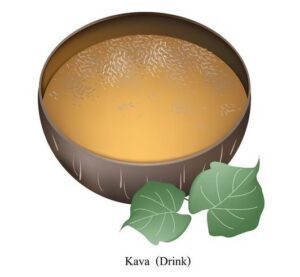 Piper methysticum (kava) has been used by South Pacific Island communities as an intoxicating beverage, and also as a sedative, muscle relaxant, anesthetic, anticonvulsant, and anodyne for urinary pain associated with venereal diseases. Kava has an anesthetic,22 numbing effect on the oral cavity, and the Lloyd Brothers – well respected manufacturing pharmacists of the early 1900s – claimed kava to specifically soothe irritated genitourinary passages. Kava teas and tinctures may help allay renal colic, and support emptying of the bladder in cases of urinary obstruction and retention. Modern research shows kava to exert an anti-cancer effect on the bladder.23,24 Liberal consumption of kava beverages, as seen with men in Fiji, may offer some protection against prostate and urinary cancer. The incidence of cancer in Fiji, in general, is one-third that of non-kava-drinking countries.25
Piper methysticum (kava) has been used by South Pacific Island communities as an intoxicating beverage, and also as a sedative, muscle relaxant, anesthetic, anticonvulsant, and anodyne for urinary pain associated with venereal diseases. Kava has an anesthetic,22 numbing effect on the oral cavity, and the Lloyd Brothers – well respected manufacturing pharmacists of the early 1900s – claimed kava to specifically soothe irritated genitourinary passages. Kava teas and tinctures may help allay renal colic, and support emptying of the bladder in cases of urinary obstruction and retention. Modern research shows kava to exert an anti-cancer effect on the bladder.23,24 Liberal consumption of kava beverages, as seen with men in Fiji, may offer some protection against prostate and urinary cancer. The incidence of cancer in Fiji, in general, is one-third that of non-kava-drinking countries.25
Much of Kava’s physiologic effects are credited to the kava lactones, including kawain, yangonin, and methysticin. Kavalactones may downregulate androgen receptors and reduce excessive stimulation of hormone-sensitive urinary tissues.26 Kavain inhibits numerous inflammatory pathways, including lipopolysaccharide-induced TNF-α production.27 Kava lactone may uncouple sodium and potassium channels from neuronal membranes, thereby reducing nerve impulses to urinary muscles and exerting a relaxing effect.28,29 Kava contributes to significant elevations of intracellular free calcium in some immune cells, and may contribute to anti-inflammatory and immune-modulating effects. Kava lactones are also well known to promote GABAergic activity and activate the associated ion channels,30 though it is less well known is that there are GABA receptors on mast cells and basophils that may contribute to kava’s anti-inflammatory and immune-modulating effects.31 Kava may also act as a cannabinoid receptor ligand and affect TRP (transient receptor potential) ion channel pharmacology, all contributing to its pain-relieving effects.32 The kava lactone, yangonin, and possibly also other kava compounds, bind cannabinoid receptors.33
Ammi visnaga for Renal Colic
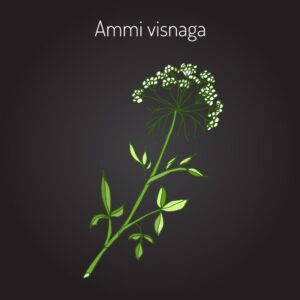 Khellin, a flavone in Ammi visnaga (khella), is used traditionally for both asthma and renal colic.34 Although the bulk of the research on Ammi visnaga has focused on mast cell-stabilizing effects (thereby inhibiting the release of inflammatory mediators in allergic situations35), Ammi visnaga has also given rise to several important calcium channel-blocking pharmaceuticals, including amiodarone, a hypotensive agent; cromolyn, a bronchial antispasmodic; and nifedipine, a urinary relaxant.36,37 Ammi visnaga also has a gentle diuretic effect, which may promote the expulsion of stones; it also may inhibit the reabsorption of citrate and decrease calcium oxalate crystal formation in the kidney.38 For acute renal colic, Ammi visnaga may be used in tinctures, teas, and in tea-soaked compresses applied topically to the back.
Khellin, a flavone in Ammi visnaga (khella), is used traditionally for both asthma and renal colic.34 Although the bulk of the research on Ammi visnaga has focused on mast cell-stabilizing effects (thereby inhibiting the release of inflammatory mediators in allergic situations35), Ammi visnaga has also given rise to several important calcium channel-blocking pharmaceuticals, including amiodarone, a hypotensive agent; cromolyn, a bronchial antispasmodic; and nifedipine, a urinary relaxant.36,37 Ammi visnaga also has a gentle diuretic effect, which may promote the expulsion of stones; it also may inhibit the reabsorption of citrate and decrease calcium oxalate crystal formation in the kidney.38 For acute renal colic, Ammi visnaga may be used in tinctures, teas, and in tea-soaked compresses applied topically to the back.
Aesculus hippocastanum – A Synergist in Renal Colic Formulas
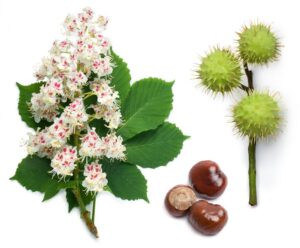 While Piper methysticum and Ammi visnaga may take the lead roles as urinary antispasmodics, Aesculus may have a valuable synergistic and supportive role in formulas for renal colic. Aesculus hippocastanum is emphasized in folklore for varicosities and edema, but is also mentioned for renal colic. Triterpenoid saponins in Aesculus, collectively referred to as β-escin, increase plasma membrane permeability (explaining its utility in edema and fluid stasis but are also able to improve the uptake of other molecules into cells.
While Piper methysticum and Ammi visnaga may take the lead roles as urinary antispasmodics, Aesculus may have a valuable synergistic and supportive role in formulas for renal colic. Aesculus hippocastanum is emphasized in folklore for varicosities and edema, but is also mentioned for renal colic. Triterpenoid saponins in Aesculus, collectively referred to as β-escin, increase plasma membrane permeability (explaining its utility in edema and fluid stasis but are also able to improve the uptake of other molecules into cells.
Beta-escin improves microcirculation, reduces vascular permeability, and increases venous tone and venous return, all serving to reduce edema. Beta-escin forms pores in the plasma membrane via effects on the cytoskeleton and cellular adhesion molecules,39 thereby increasing entrance of heparin and calmodulin. Although β-escin has been shown to boost agonist-induced contraction in urinary smooth muscle,40 it also appears to boost the anti-allergy and anti-inflammatory actions of various compounds.41 Beta-escin is credited with significant anti-edema effects39 and may serve as a complementary herb in formulas for renal colic, improving the delivery of other herbs. Aesculus may also enhance absorption and provide its own anodyne effects when included in topical preparations to treat inflammation and swelling.42 (See the topical heat pack formula for renal colic.)
References:
- Golzari SE, Soleimanpour H, Rahmani F, et al. Therapeutic Approaches for Renal Colic in the Emergency Department: A Review Article. Anesth Pain Med. 2014;4(1):e16222.
- Liang W, Teong IW, Koon JC, et al. Inhibitory effects of salviae miltiorrhizae radix (danshen) and puerariae lobatae radix (gegen) in carbachol-induced rat detrusor smooth muscle contractility. Int J Physiol Pathophysiol Pharmacol. 2012;4(1):36-44.
- Zaitouna M, Alsaid B, Lebacle C, et al. Origin and nature of pelvic ureter innervation. Neurourol Urodyn. 2017;36(2):271-279.
- Yamamichi F, Shigemura K, Behnsawy HM, et al. Beta-3 adrenergic receptors could be significant factors for overactive bladder-related symptoms. Int J Clin Exp Pathol. 2015;8(9):11863-11870.
- Kaya E, Sikka SC, Oral DY, et al. B3-Adrenoceptor Control Of Lower Genıtourınary Tract Organs And Functıon In Male: An Overvıew. Curr Drug Targets. 2017 Jan 20. [Epub ahead of print]
- Nishimune A, Yoshiki H, Uwada J, et al. Phenotype pharmacology of lower urinary tract α1-adrenoceptors. Br J Pharmacol. 2012;165(5):1226-1234.
- Afeli SA, Petkov GV. Functional BK channels facilitate the β3-adrenoceptor agonist-mediated relaxation of nerve-evoked contractions in rat urinary bladder smooth muscle isolated strips. Eur J Pharmacol. 2013;711(1-3):50-56.
- Osorio L, Lima E, Autorino R, Marcelo F. Emergency management of ureteral stones: Recent advances. Indian J Urol. 2008;24(4):461-466.
- de Groat WC, Griffiths D, Yoshimura N. Neural control of the lower urinary tract. Compr Physiol. 2015;5(1):327-396.
- Suzuki M, Ito Y, Fujino T, et al. Pharmacological effects of saw palmetto extract in the lower urinary tract. Acta Pharmacol Sin. 2009;30(3):271-281.
- Tabner AJ, Johnson GD, Fakis A, et al. β-Adrenoreceptor agonists in the management of pain associated with renal colic: a systematic review. BMJ Open. 2016;6(6):e011315.
- D’Agostino G, Bolognesi ML, Lucchelli A, et al. Prejunctional muscarinic inhibitory control of acetylcholine release in the human isolated detrusor: involvement of the M4 receptor subtype. Br J Pharmacol. 2000;129(3):493-500.
- Ng YK, de Groat WC, Wu HY. Muscarinic regulation of neonatal rat bladder spontaneous contractions. Am J Physiol Regul Integr Comp Physiol. 2006;291(4):R1049-R1059.
- Dwoskin LP, Crooks PA. A novel mechanism of action and potential use for lobeline as treatment for psychostimulant abuse. Biochem Pharmacol. 2002;63(2):89-98.
- Neugebauer NM, Harrod SB, Stairs DJ, et al. Lobelane decreases methamphetamine self-administration in rats. Eur J Pharmacol. 2007;571(1):33-38.
- Bartolini A, Di Cesare Mannelli L, Ghelardini C. Analgesic and antineuropathic drugs acting through central cholinergic mechanisms. Recent Pat CNS Drug Discov. 2011;6(2):119-140.
- Reza HM, Mohammad H, Golnaz E, Gholamreza S. Effect of methanolic extract of Hyoscymus niger L. on the seizure induced by picritoxin in mice. Pak J Pharm Sci. 2009;22(3):308-312.
- Alizadeh A, Moshiri M, Alizadeh J, Balali-Mood M. Black henbane and its toxicity – a descriptive review. Avicenna J Phytomed. 2014;4(5):297-311.
- Gilani AH, Khan AU, Raoof M, et al. Gastrointestinal, selective airways and urinary bladder relaxant effects of Hyoscyamus niger are mediated through dual blockade of muscarinic receptors and Ca2+ channels. Fundam Clin Pharmacol. 2008;22(1):87-99.
- Gurbuz MC, Polat H, Canat L, et al. Efficacy of three different alpha 1-adrenergic blockers and hyoscine N-butylbromide for distal ureteral stones. Int Braz J Urol. 2011;37(2):195-200; discussion 201-202.
- Zhang YM, Chu P, Wang WJ. PRISMA-combined α-blockers and antimuscarinics for ureteral stent-related symptoms: A meta-analysis. Medicine (Baltimore). 2017;96(7):e6098.
- Bilia AR, Scalise L, Bergonzi MC, Vincieri F. Effect of surfactants and solutes (glucose and NaCl) on solubility of Kavain—a technical note. AAPS PharmSciTech. 2008;9(2):444-448.
- Leitzman P, Narayanapillai SC, Balbo S, et al. Kava blocks 4-(methylnitrosamino)-1-(3-pyridyl)-1-butanone-induced lung tumorigenesis in association with reducing O6-methylguanine DNA adduct in A/J mice. Cancer Prev Res (Phila). 2014;7(1):86-96.
- Tang Y, Simoneau AR, Xie J, et al. Effects of the kava chalcone flavokawain A differ in bladder cancer cells with wild-type versus mutant p53. Cancer Prev Res (Phila). 2008;1(6):439-451.
- Agarwal R, Deep G. Kava, a tonic for relieving the irrational development of natural preventive agents. Cancer Prev Res (Phila). 2008;1(6):409-412.
- Li X, Liu Z, Xu X, et al. Kava components down-regulate expression of AR and AR splice variants and reduce growth in patient-derived prostate cancer xenografts in mice. PLoS One. 2012;7(2):e31213.
- Tang X, Amar S. Kavain Inhibition of LPS-Induced TNF-α via ERK/LITAF. Toxicol Res (Camb). 2016;5(1):188-196.
- Alramadhan E, Hanna MS, Hanna MS, et al. Dietary and botanical anxiolytics. Med Sci Monit. 2012;18(4):RA40-RA48.
- Weeks BS. Formulations of dietary supplements and herbal extracts for relaxation and anxiolytic action:Relarian. Med Sci Monit. 2009;15(11):RA256-RA262.
- Chua HC, Christensen ET, Hoestgaard-Jensen K. Kavain, the Major Constituent of the Anxiolytic Kava Extract, Potentiates GABAA Receptors: Functional Characteristics and Molecular Mechanism. PLoS One. 2016;11(6):e0157700.
- Dietz BM, Bolton JL. Biological reactive intermediates (BRIs) formed from botanical dietary supplements. Chem Biol Interact. 2011;192(1-2):72-80.
- Shimoda LM, Showman A, Baker JD, et al. Differential regulation of calcium signalling pathways by components of Piper methysticum (‘Awa). Phytother Res. 2015;29(4):582-590.
- McPartland JM, Guy GW, Di Marzo V. Care and feeding of the endocannabinoid system: a systematic review of potential clinical interventions that upregulate the endocannabinoid system. PLoS One. 2014;9(3):e89566.
- Bhagavathula AS, Mahmoud Al-Khatib AJ, Elnour AA, et al. Ammi Visnaga in treatment of urolithiasis and hypertriglyceridemia. Pharmacognosy Res. 2015;7(4):397-400.
- Mali RG, Dhake AS. A review on herbal antiasthmatics. Orient Pharm Exp Med. 2011;11(2):77-90.
- Cao D, Yang L, Liu L, et al. A comparison of nifedipine and tamsulosin as medical expulsive therapy for the management of lower ureteral stones without ESWL. Sci Rep. 2014;4:5254.
- McClinton S, Starr K, Thomas R. Use of drug therapy in the management of symptomatic ureteric stones in hospitalized adults (SUSPEND), a multicentre, placebo-controlled, randomized trial of a calcium-channel blocker (nifedipine) and an α-blocker (tamsulosin): study protocol for a randomized controlled trial. Trials. 2014;15:238.
- Vanachayangkul P, Chow N, Khan SR,, Butterweck V. Prevention of renal crystal deposition by an extract of Ammi visnaga L. and its constituents khellin and visnagin in hyperoxaluric rats. Urol Res. 2011;39(3):189-195.
- Domanski D, Zegrocka-Stendel O, Perzanowska A, et al. Molecular Mechanism for Cellular Response to β-Escin and Its Therapeutic Implications. PLoS One. 2016;11(10):e0164365.
- Durlu-Kandilci NT, Brading AF. Involvement of Rho kinase and protein kinase C in carbachol-induced calcium sensitization in β-escin skinned rat and guinea-pig bladders. Br J Pharmacol. 2006;148(3):376-384.
- Lindner I, Meier C, Url A, et al. Beta-escin has potent anti-allergic efficacy and reduces allergic airway inflammation. BMC Immunol. 2010;11:24.
- Wetzel D, Menke W, Dieter R, et al. Escin/diethylammonium salicylate/heparin combination gels for the topical treatment of acute impact injuries: a randomised, double blind, placebo controlled, multicentre study. Br J Sports Med. 2002;36(3):183-188.
Image Copyright: <a href=’https://www.123rf.com/profile_hywards’>hywards / 123RF Stock Photo</a>

Jillian Stansbury, ND, has practiced in SW Washington for nearly 20 years, specializing in women’s health, mental health, and chronic disease. She holds undergraduate degrees in medical illustration and medical assisting, and graduated with honors in both programs. Dr Stansbury also chaired the botanical medicine program at NCNM and has taught the core botanical curricula for more than 20 years. She also writes and serves as a medical editor for numerous professional journals and lay publications, and teaches natural products chemistry and herbal medicine around the country. She is presently working to set up a humanitarian service organization in Peru and is studying South American ethnobotany. She is the mother of 2 adult children, and enjoys art, music, gardening, camping, international travel, and the study of quantum and metaphysics.

